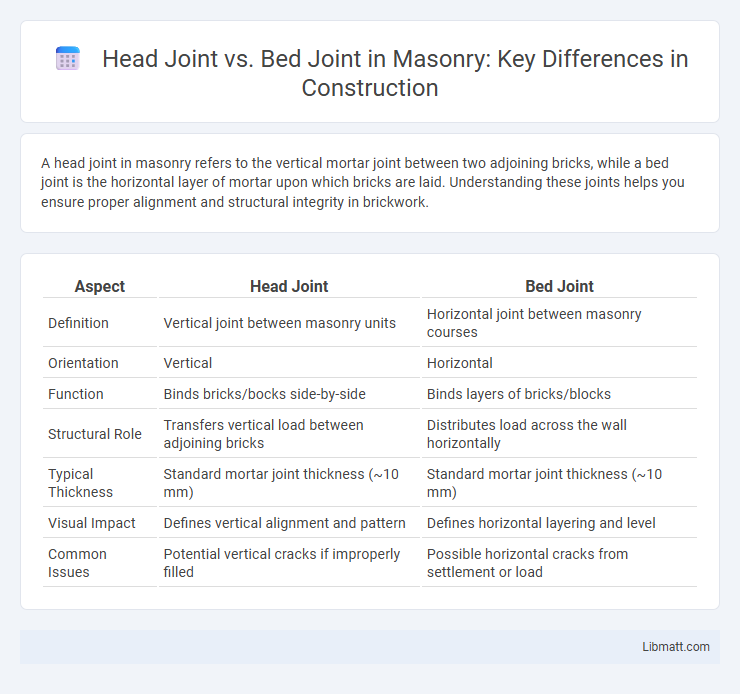A head joint in masonry refers to the vertical mortar joint between two adjoining bricks, while a bed joint is the horizontal layer of mortar upon which bricks are laid. Understanding these joints helps you ensure proper alignment and structural integrity in brickwork.
Table of Comparison
| Aspect | Head Joint | Bed Joint |
|---|---|---|
| Definition | Vertical joint between masonry units | Horizontal joint between masonry courses |
| Orientation | Vertical | Horizontal |
| Function | Binds bricks/bocks side-by-side | Binds layers of bricks/blocks |
| Structural Role | Transfers vertical load between adjoining bricks | Distributes load across the wall horizontally |
| Typical Thickness | Standard mortar joint thickness (~10 mm) | Standard mortar joint thickness (~10 mm) |
| Visual Impact | Defines vertical alignment and pattern | Defines horizontal layering and level |
| Common Issues | Potential vertical cracks if improperly filled | Possible horizontal cracks from settlement or load |
Understanding Head Joints and Bed Joints in Masonry
Head joints and bed joints are essential components in masonry, with head joints being the vertical mortar joints between bricks and bed joints the horizontal layers upon which bricks rest. Properly understanding the differences helps ensure structural stability and effective load distribution in your masonry project. Both joints play critical roles in brick alignment, moisture control, and overall wall strength.
Definition of Head Joint
The head joint in masonry refers to the vertical mortar joint between two adjacent bricks or blocks in a wall. It plays a crucial role in bonding units side-by-side, contributing to the wall's overall structural integrity and aesthetic appearance. Properly filled and tooled head joints help prevent water penetration and improve weather resistance in brickwork.
Definition of Bed Joint
A bed joint in masonry refers to the horizontal layer of mortar placed between courses of bricks or blocks, providing structural support and even distribution of loads across the wall. It plays a crucial role in bonding the masonry units together, ensuring stability and strength. Understanding the difference between head joints (vertical mortar joints) and bed joints helps you achieve precise workmanship and durable construction results.
Structural Role of Head Joints
Head joints in masonry serve a critical structural role by binding adjacent bricks together across the wall's thickness, enhancing lateral stability and load distribution. Unlike bed joints that primarily transfer vertical loads, head joints help resist shear forces and contribute to the wall's overall rigidity. Understanding the specific function of head joints can improve your masonry's durability and strength by ensuring proper mortar application and alignment.
Structural Role of Bed Joints
Bed joints in masonry serve a critical structural role by evenly distributing the load from the courses above, providing stability and strength to the wall assembly. Unlike head joints, which primarily bond bricks laterally, bed joints absorb vertical pressures and help resist shear forces, ensuring overall durability. Properly executed bed joints enhance your wall's ability to handle compressive stress and prevent uneven settling or cracking.
Differences Between Head Joint and Bed Joint
Head joints run vertically between masonry units, filling the gap between the ends of bricks, while bed joints are horizontal layers that separate rows of bricks. The head joint primarily affects the vertical alignment and structural stability of the wall, whereas the bed joint supports the weight distribution and bonding of the masonry course. Understanding the differences between head joint and bed joint helps in diagnosing mortar deterioration and ensuring the longevity of your masonry construction.
Importance of Proper Joint Placement
Proper joint placement in masonry, specifically distinguishing between head joints and bed joints, is crucial for structural integrity and moisture control. Bed joints, laid horizontally between courses, bear the majority of the load and require consistent thickness to evenly distribute weight, while head joints, vertical spaces between bricks, influence the wall's water resistance and aesthetic appearance. Ensuring your masonry features correctly positioned and well-packed bed and head joints prevents cracking, improves durability, and enhances the overall performance of the structure.
Common Issues with Head and Bed Joints
Common issues with head joints in masonry include inadequate mortar fill, leading to water penetration and reduced structural stability. Bed joints often experience cracking or uneven thickness, causing weak bonding between brick courses and potential moisture retention. Ensuring consistent application and proper curing of mortar enhances the durability and weather resistance of both head and bed joints in your masonry work.
Techniques for Quality Masonry Joints
Achieving quality masonry joints requires precise control over head joint and bed joint techniques, emphasizing consistent mortar thickness and proper tooling to ensure structural integrity and weather resistance. Head joints, which are vertical, need uniform mortar application between bricks to maintain alignment and seal gaps, while bed joints, the horizontal layers, demand careful leveling and compacting of mortar to support weight distribution. Proper curing and joint finishing methods, such as concave or struck tooling, enhance joint durability and aesthetics in masonry construction.
Best Practices for Head and Bed Joint Construction
Properly constructing head joints and bed joints is crucial for masonry strength and durability. Ensure head joints, which run perpendicular to bed joints, are consistently filled with mortar to prevent water ingress and maintain structural integrity. Your best practice involves tooling joints to create a uniform profile, promoting weather resistance and aesthetic appeal while allowing for controlled movement within the masonry assembly.
Head joint vs Bed joint (masonry) Infographic

 libmatt.com
libmatt.com